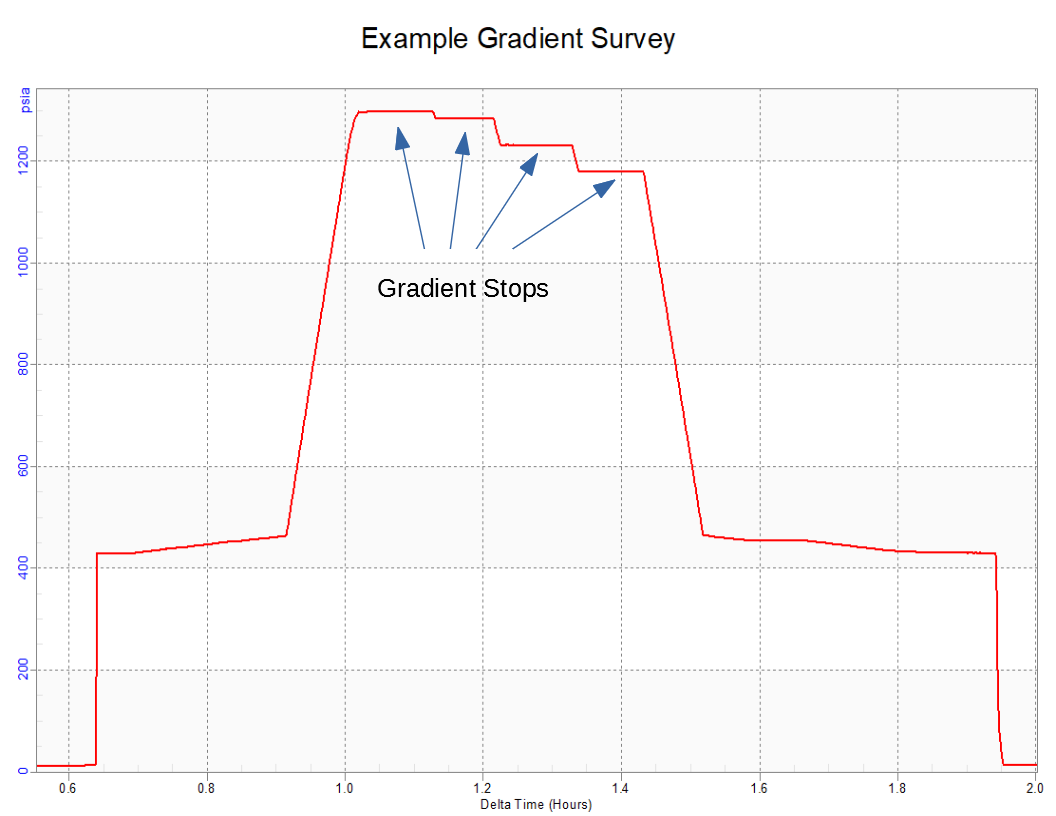Want to read more? Click here for more Well Insights.
HOW TO RUN A PRESSURE GRADIENT SURVEY
A pressure gradient survey is a simple type of well test that is designed to answer two questions:
What is the bottomhole pressure?
How much fluid (if any) is there downhole?
By answering these two questions, we can take significant steps toward optimizing the production on a well, and we can gain valuable insight into the reservoir pressure. In a gas well, the bottomhole pressure is often estimated based on the surface pressure, however, if there is a significant amount of fluid downhole, then the surface pressure will be deceivingly low. This could cause you to underestimate the gas reserves and production potential.
Pressure gradient surveys are generally run with downhole memory gauges on slickline. By using slickline rather than electric line, the survey can be completed quickly, as there is much less rig-up and rig-down. Because memory gauges do not have a depth measurement in the data, survey points must be taken so that the pressure and temperature data can be calibrated with depth. This is done simply by making “gradient stops”, which involves stopping the gauge at a specific depth for 5- minutes, while taking note of the depth and time of the gradient stop. This is done at several points in the well and when the data is downloaded after the test, those gradient stops will be easily identified.
Identifying The Fluid Level
A gradient survey will not only tell you if there is fluid downhole, but if it is done properly, you will be able to calculate the fluid density and the fluid depth. To do this, at least two gradient stops must be made in each phase (gas, water, oil) to determine a “pressure gradient” (psi/ft) of that phase. The calculation of a pressure gradient is very simple:
Once the survey points have been collected and analyzed, these points can be placed on a graph of depth vs. pressure. From the graph the various phases can be clearly seen based on the slope of the trendline. The point at which the different trendlines intersect can be assumed to be a fluid interface. In other words, the fluid level is found at the intersection of the trendlines.
In addition to the graphical method, the fluid level can also be calculated mathematically, by calculating the slope of each line, and then calculating the intersection point.
How to run a gradient survey
Gradient surveys can be run both with the well shut in (static gradient survey) or with the well flowing (flowing gradient survey). Both methods reveal slightly different information about a well, however, a static gradient survey is much more common due to its simplicity and the fact that the bottomhole pressure can be representative of the reservoir pressure.
A properly run gradient survey will have at least two survey points in each fluid phase. This means that for a two-phase gas well (gas and water), that four gradient stops are necessary. However, since we don’t know the fluid at the beginning of the test (if we knew the fluid level we wouldn’t need to do a gradient survey in the first place), it is generally a good idea to make an extra gradient stop or two to make sure that we are have at least two points in each phase.
With this in mind, here is a standard procedure that we (FyreRok) use on a lot of two-phase gas wells:
Run in the hole and tag TD
Point 1 – TD minus 1 foot (fluid)
Point 2 – TD minus 25 feet (fluid)
Point 3 – TD minus 50 feet (fluid)
Point 4 – Half way up the well (gas)
Point 5 – Surface (gas)
*All gradient stops last 5-minutes
All three of the gradient stops at the bottom of the well will likely be in fluid. This means a clear fluid trendline can be formed. Additionally, the last two points (4 and 5) will likely be in gas, which means that a clear gas trendline can be formed. The intersection of these two points will represent the fluid level in the well.
A pressure gradient survey is a very simple type of well test that can reveal critical information about the well. If designed correctly, gradient surveys can be cheap and quick, and can answer important questions that can be used to improve well performance and reservoir models.
Do you need help with your next gradient survey? Give us a call.
Want to read more? Click here for more Well Insights.
You can also subscribe to receive Well Insights updates directly to your inbox.



